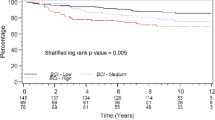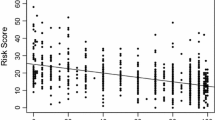Summary
Background. There is a need for reliable predictors of breast cancer aggressiveness that will further refine the staging classification and help guide the implementation of novel therapies. We have identified RhoC as being nearly always overexpressed in the most aggressive form of breast cancer, inflammatory breast cancer (IBC); in subsequent work we identified RhoC to be a promising marker of aggressive behavior in breast cancers less than 1 cm in diameter. We hypothesized that RhoC expression would identify aggressive, non-IBC tumors breast cancer patients at any stage with worse outcomes defined as recurrence and/or metastasis.
Methods. We constructed four high-density tissue microarrays (TMAs) using 801 tissue cores from 280 patients. These tissues represent a wide range of normal breast and breast disease, including intraductal hyperplasia, ductal carcinoma in situ (DCIS), invasive carcinomas, and distant metastases. The TMAs were immunostained using a polyclonal anti-RhoC antibody developed in our laboratory. Cytoplasmic RhoC expression was scored as negative, weak, moderate, or strong by a previously validated scoring schema.
Results. RhoC expression increases with breast cancer progression. All samples of normal breast epithelium had negative to weak staining, whereas staining intensity increased in hyperplasia, DCIS, invasive carcinoma, and metastases (Kruskal–Wallis p < 0.001). In patients with invasive carcinoma, high RhoC expression was associated with features of aggressive behavior including high histologic grade, positive lymph nodes, and negative hormonal receptor status. High RhoC expression was a predictor of overall survival in patients with breast cancer (log rank test, p = 0.002) and was associated with 100% increase in the risk of death as compared to patients with low RhoC expression. Importantly, high RhoC was an independent predictor of poor response to doxorubicin-based chemotherapy with a hazard ratio of 3.1 and a 95% CI of 1.2–7.7 (p = 0.02).
Conclusion. RhoC expression increases with breast cancer progression and RhoC protein level in tumor tissue is strongly associated with biologically aggressive invasive carcinomas of the breast. RhoC expression, if validated, may identify patients who are less likely benefit from doxorubicin therapy and suggests RhoC overexpression as a new target for intervention.
Similar content being viewed by others
References
A Jemal T Murray A Samuels A Ghafoor E Ward MJ Thun (2003) ArticleTitleCancer statistics CA Cancer J Clin 53 5–26 Occurrence Handle12568441
M Ellis D Hayes M Lippman (2000) Treatment of metastatic disease J Harris ME Lippman M Morrow (Eds) Diseases of the Breast Lippincott-Raven Philadelpha 749–798
DF Hayes C Isaacs V Stearns (2001) ArticleTitlePrognostic factors in breast cancer: current and new predictors of metastasis J Mammary Gland Biol Neoplasia 6 375–392 Occurrence Handle10.1023/A:1014778713034 Occurrence Handle12013528
DF Hayes B Trock AL Harris (1998) ArticleTitleAssessing the clinical impact of prognostic factors: when is “statistically significant” clinically useful? Breast Cancer Res Treat 52 305–319 Occurrence Handle10.1023/A:1006197805041 Occurrence Handle10066089
GM Clark (1996) Prognostic and predictive factors LM. J Harris M Morrow S Hellman (Eds) , Diseases of the Breast Lipponcott-Raven Publishers Philadephia 461–485
Hayes (2000) ArticleTitleDo we need prognostic factors in nodal-negative breast cancer? Arbiter Eur J Cancer 36 302–306 Occurrence Handle10.1016/S0959-8049(99)00303-2
KL Golen Particlevan S Davies ZF Wu Y Wang CD Bucana H Root S Chandrasekharappa M Strawderman SP Ethier SD Merajver (1999) ArticleTitleA novel putative low-affinity insulin-like growth factor-binding protein, LIBC (lost in inflammatory breast cancer), and RhoC GTPase correlate with the inflammatory breast cancer phenotype Clin Cancer Res 5 2511–2519 Occurrence Handle10499627
KL Golen Particlevan ZF Wu XT Qiao L Bao SD Merajver (2000) ArticleTitleRhoC GTPase overexpression modulates induction of angiogenic factors in breast cells Neoplasia 2 418–425 Occurrence Handle10.1038/sj.neo.7900115 Occurrence Handle11191108
KL Golen Particlevan ZF Wu XT Qiao LW Bao SD Merajver (2000) ArticleTitleRhoC GTPase, a novel transforming oncogene for human mammary epithelial cells that partially recapitulates the inflammatory breast cancer phenotype Cancer Res 60 5832–5838 Occurrence Handle11059780
CG Kleer KL Golen Particlevan Y Zhang ZF Wu MA Rubin SD Merajver (2002) ArticleTitleCharacterization of RhoC expression in benign and malignant breast disease : a potential new marker for small breast carcinomas with metastatic ability Am J Pathol 160 579–584 Occurrence Handle11839578
CG Kleer Q Cao S Varambally R Shen I Ota SA Tomlins D Ghosh RG Sewalt AP Otte DF Hayes MS Sabel D Livant SJ Weiss MA Rubin AM Chinnaiyan (2003) ArticleTitleEZH2 is a marker of aggressive breast cancer and promotes neoplastic transformation of breast epithelial cells Proc Natl Acad Sci USA 100 11606–11611 Occurrence Handle10.1073/pnas.1933744100 Occurrence Handle14500907
EE Perrone C Theoharis NR Mucci S Hayasaka JM Taylor KA Cooney MA Rubin (2000) ArticleTitleTissue microarray assessment of prostate cancer tumor proliferation in African-American and white men J Natl Cancer Inst 92 937–939 Occurrence Handle10.1093/jnci/92.11.937 Occurrence Handle10841830
EW Elston IO Ellis (1993) ArticleTitleMethod for grading breast cancer J Clin Pathol 46 189–190
S Manley NR Mucci AM Marzo ParticleDe MA Rubin (2001) ArticleTitleRelational database structure to manage high-density tissue microarray data and images for pathology studies focusing on clinical outcome: the prostate specialized program of research excellence model Am J Pathol 159 837–843 Occurrence Handle11549576
DR Rhodes MG Sanda AP Otte AM Chinnaiyan MA Rubin (2003) ArticleTitleMultiplex biomarker approach for determining risk of prostate-specific antigen-defined recurrence of prostate cancer J Natl Cancer Inst 95 661–668 Occurrence Handle12734317
CD Nobes A Hall (1995) ArticleTitleRho, rac, and cdc42 GTPases regulate the assembly of multimolecular focal complexes associated with actin stress fibers, lamellipodia, and filopodia Cell 81 53–62 Occurrence Handle10.1016/0092-8674(95)90370-4 Occurrence Handle7536630
A Hall CD Nobes (2000) ArticleTitleRho GT Pases molecular switches that control the organization and dynamics of the actin cytoskeleton Philos Trans R Soc Lond B Biol Sci 355 965–970 Occurrence Handle10.1098/rstb.2000.0632 Occurrence Handle11128990
T Leung XQ Chen E Manser L Lim (1996) ArticleTitleThe p160 RhoA-binding kinase ROK alpha is a member of a kinase family and is involved in the reorganization of the cytoskeleton Mol Cell Biol 16 5313–5327 Occurrence Handle8816443
CG Kleer Y Zhang Q Pan G Gallagher M Wu ZF Wu SD Merajver (2004) ArticleTitleWISP3 and RhoC guanosine triphosphatase cooperate in the development of inflammatory breast cancer Breast Cancer Res 6 R110–R115 Occurrence Handle10.1186/bcr755
MA Wozniak R Desai PA Solski CJ Der PJ Keely (2003) ArticleTitleROCK-generated contractility regulates breast epithelial cell differentiation in response to the physical properties of a three-dimensional collagen matrix J Cell Biol 163 583–595 Occurrence Handle10.1083/jcb.200305010 Occurrence Handle14610060
H Suwa G Ohshio T Imamura G Watanabe S Arii M Imamura S Narumiya H Hiai M Fukumoto (1998) ArticleTitleOverexpression of the RhoC gene correlates with progression of ductal adenocarcinoma of the pancreas Br J Cancer 77 147–152 Occurrence Handle9459160
A Horiuchi T Imai C Wang S Ohira Y Feng T Nikaido I Konishi (2003) ArticleTitleUp-regulation of small GTPases, RhoA and RhoC, is associated with tumor progression in ovarian carcinoma Lab Invest 83 861–870 Occurrence Handle12808121
T Kamai T Tsujii K Arai K Takagi H Asami Y Ito H Oshima (2003) ArticleTitleSignificant association of Rho/ROCK pathway with invasion and metastasis of bladder cancer Clin Cancer Res 9 2632–2641 Occurrence Handle12855641
T Kondo K Sentani N Oue K Yoshida H Nakayama W Yasui (2004) ArticleTitleExpression of RHOC is associated with metastasis of gastric carcinomas Pathobiology 71 19–25 Occurrence Handle10.1159/000072958 Occurrence Handle14555841
Y Shikada I Yoshino T Okamoto S Fukuyama T Kameyama Y Maehara (2003) ArticleTitleHigher expression of RhoC is related to invasiveness in non-small cell lung carcinoma Clin Cancer Res 9 5282–5286 Occurrence Handle14614010
W Wang LY Yang ZL Yang GW Huang WQ Lu (2003) ArticleTitleExpression and significance of RhoC gene in hepatocellular carcinoma World J Gastroenterol 9 1950–1953 Occurrence Handle12970882
T Ikoma T Takahashi S Nagano YM Li Y Ohno K Ando T Fujiwara H Fujiwara K Kosai (2004) ArticleTitleA definitive role of RhoC in metastasis of orthotopic lung cancer in mice Clin Cancer Res 10 1192–1200 Occurrence Handle14871999
EA Clark TR Golub ES Lander RO Hynes (2000) ArticleTitleGenomic analysis of metastasis reveals an essential role for RhoC Nature 406 532–535 Occurrence Handle10.1038/35020106 Occurrence Handle10952316
KM Carr M Bittner JM Trent (2003) ArticleTitleGene-expression profiling in human cutaneous melanoma Oncogene 22 3076–3080 Occurrence Handle10.1038/sj.onc.1206448 Occurrence Handle12789283
MC Seabra (1998) ArticleTitleMembrane association and targeting of prenylated Ras-like GTPases Cell Signal 10 167–172 Occurrence Handle10.1016/S0898-6568(97)00120-4 Occurrence Handle9607139
PT Kirschmeier D Whyte O Wilson WR Bishop JK Pai (2001) ArticleTitleIn vivo prenylation analysis of Ras and Rho proteins Methods Enzymol 332 115–127 Occurrence Handle11305090
P Adamson CJ Marshall A Hall PA Tilbrook (1992) ArticleTitlePost-translational modifications of p21rho proteins J Biol Chem 267 20033–20038 Occurrence Handle1400319
M Sinensky (2000) ArticleTitleRecent advances in the study of prenylated proteins Biochim Biophys Acta 1484 93–106 Occurrence Handle10760460
AL Bishop A Hall (2000) ArticleTitleRho GTPases and their effector proteins Biochem J 348 IssueIDPt2 241–255 Occurrence Handle10.1042/0264-6021:3480241 Occurrence Handle10816416
CA Omer Z Chen RE Diehl MW Conner HY Chen ME Trumbauer S Gopal-Truter G Seeburger H Bhimnathwala MT Abrams JP Davide MS Ellis JB Gibbs I Greenberg KS Koblan AM Kral D Liu RB Lobell PJ Miller SD Mosser TJ O’Neill E Rands MD Schaber ET Senderak A Oliff NE Kohl (2000) ArticleTitleMouse mammary tumor virus-Ki-rasB transgenic mice develop mammary carcinomas that can be growth-inhibited by a farnesyl:protein transferase inhibitor Cancer Res 60 2680–2688 Occurrence Handle10825141
GC Prendergast R Khosravi-Far PA Solski H Kurzawa PF Lebowitz CJ ParticleDer (1995) ArticleTitleCritical role of Rho in cell transformation by oncogenic Ras Oncogene 10 2289–2296 Occurrence Handle7784077
GC Prendergast JP Davide SJ deSolms EA Giuliani SL Graham JB Gibbs A Oliff NE Kohl (1994) ArticleTitleFarnesyltransferase inhibition causes morphological reversion of ras-transformed cells by a complex mechanism that involves regulation of the actin cytoskeleton Mol Cell Biol 14 4193–4202 Occurrence Handle8196657
PF Lebowitz PJ Casey GC Prendergast JA Thissen (1997) ArticleTitleFarnesyltransferase inhibitors alter the prenylation and growth-stimulating function of RhoB J Biol Chem 272 15591–15594 Occurrence Handle10.1074/jbc.272.25.15591 Occurrence Handle9188444
KL Golen Particlevan L Bao MM DiVito Z Wu GC Prendergast SD Merajver (2002) ArticleTitleReversion of RhoC GTPase-induced inflammatory breast cancer phenotype by treatment with a farnesyl transferase inhibitor Mol Cancer Ther 1 575–583 Occurrence Handle12479217
EA Collisson C Kleer M Wu A De SS Gambhir SD Merajver MS Kolodney (2003) ArticleTitleAtorvastatin prevents RhoC isoprenylation, invasion, and metastasis in human melanoma cells Mol Cancer Ther 2 941–948 Occurrence Handle14578459
Author information
Authors and Affiliations
Corresponding author
Rights and permissions
About this article
Cite this article
Kleer, C.G., Griffith, K.A., Sabel, M.S. et al. RhoC-GTPase is a Novel Tissue Biomarker Associated with Biologically Aggressive Carcinomas of the Breast. Breast Cancer Res Treat 93, 101–110 (2005). https://doi.org/10.1007/s10549-005-4170-6
Issue Date:
DOI: https://doi.org/10.1007/s10549-005-4170-6




